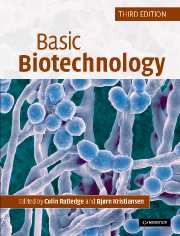Book contents
- Frontmatter
- Contents
- List of contributors
- Preface to the second edition
- Preface to the third edition
- Part I Fundamentals and principles
- Part II Practical applications
- Chapter 12 High-throughput screening and process optimisation
- Chapter 13 The business of biotechnology
- Chapter 14 Amino acids
- Chapter 15 Organic acids
- Chapter 16 Microbial polysaccharides and single cell oils
- Chapter 17 Environmental applications
- Chapter 18 Production of antibiotics by fermentation
- Chapter 19 Strategies of cultivation
- Chapter 20 Enzyme biotechnology
- Chapter 21 Recombinant proteins of high value
- Chapter 22 Insect and mammalian cell culture
- Chapter 23 Plant cell biotechnology
- Chapter 24 Biotransformations
- Chapter 25 Immunochemical applications
- Index
Chapter 16 - Microbial polysaccharides and single cell oils
Published online by Cambridge University Press: 05 June 2012
- Frontmatter
- Contents
- List of contributors
- Preface to the second edition
- Preface to the third edition
- Part I Fundamentals and principles
- Part II Practical applications
- Chapter 12 High-throughput screening and process optimisation
- Chapter 13 The business of biotechnology
- Chapter 14 Amino acids
- Chapter 15 Organic acids
- Chapter 16 Microbial polysaccharides and single cell oils
- Chapter 17 Environmental applications
- Chapter 18 Production of antibiotics by fermentation
- Chapter 19 Strategies of cultivation
- Chapter 20 Enzyme biotechnology
- Chapter 21 Recombinant proteins of high value
- Chapter 22 Insect and mammalian cell culture
- Chapter 23 Plant cell biotechnology
- Chapter 24 Biotransformations
- Chapter 25 Immunochemical applications
- Index
Summary
Introduction
When micro-organisms are provided with a surplus of glucose, or another source of carbon and energy, they may produce one or more intracellular storage compounds that will then be usable by the microorganism should it subsequently face deprivation of a carbon source, i.e. starvation. Some yeasts, fungi and a few microalgae accumulate large amounts of oil, or lipids. Bacteria more commonly accumulate a polymer known as polyhydroxyalkanoate (PHA). Both types of storage compound can be seen (under the microscope) as forming distinct inclusions within the cells. Concentrations of them can reach 70%, or even more, of the cell dry weight in certain species. Glycogen (a polymer of glucose that is sometimes referred to as bacterial starch) and trehalose (a disaccharide) are other well known examples of microbial storage compounds. Some microorganisms may, instead of producing PHA or lipids, synthesise large amounts of polysaccharides – the amounts are often so large that they are excreted from the cells and, in contrast to the other storage compounds, are thus extracellular.
The synthesis of all these products is promoted when growth is restricted by the availability of an essential nutrient other than carbon. Usually nitrogen is chosen as the limiting nutrient. Thus when the cells run out of nitrogen they still continue to assimilate the carbon source but, because cell growth can no longer occur as nitrogen is essential for protein and nucleic acid synthesis, this incoming carbon is channelled into a storage compound.
- Type
- Chapter
- Information
- Basic Biotechnology , pp. 381 - 402Publisher: Cambridge University PressPrint publication year: 2006
- 1
- Cited by



